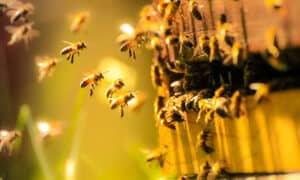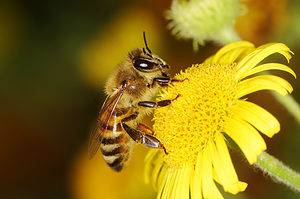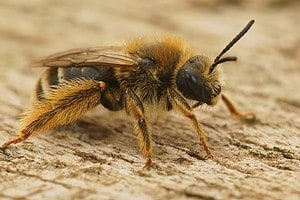When it comes to telling a carpenter bee vs. bumble bee apart, what clues can you use in order to accomplish this? While both of these insects look strikingly similar, they are very different and in a vast variety of ways. For example, carpenter bees are members of the Xylocopa family, while bumble bees are members of the Bombus family. But this is only where their differences begin.
In this article, we will discuss all of the key differences between a carpenter bee vs bumble bee, as well as give you some clues as to how you can best tell them apart. Let’s get started and learn about these unique insects now.
Comparing Carpenter Bee vs Bumble Bee

| Carpenter Bee | Bumble Bee | |
|---|---|---|
| Stinger? | Males no; females yes | Both genders, yes |
| Appearance | Shiny black abdomen; segmented body | Fuzzy body, looks to be all one piece, with black and yellow stripes |
| Size | 1 inch in length; large wings | ½ inch to 1 inch in length; shorter wings |
| Classification | Xylocopa | Bombus |
| Behavior | Carves tunnels and compartments into wood and other surfaces; flies in a sporadic way | Builds hives along the ground in abandoned burrows, piles of rocks or landscaping, and under vegetation; flies smoothly |
The Main Differences Between Carpenter Bee vs Bumble Bee
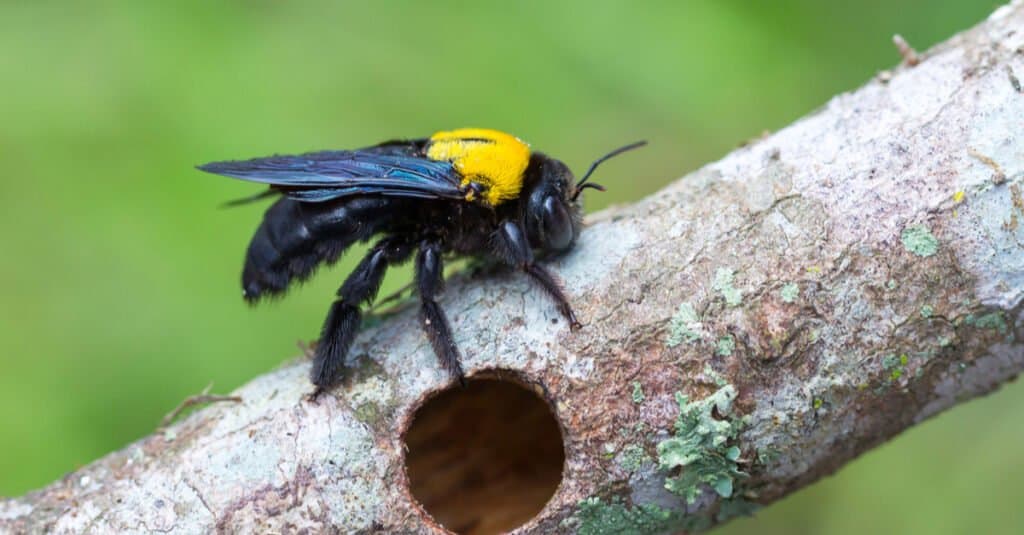
Carpenter bees live in wooden materials where they carve their own tunnels, while bumble bees tend to take over abandoned burrows.
©Zety Akhzar/Shutterstock.com
There are many key differences between a carpenter bee vs bumble bee. A carpenter bee lives in wooden materials where they carve their own tunnels, while bumble bees tend to take over abandoned burrows and other low-lying holes that they can protect. All bumble bees also have stingers, while only female carpenter bees have stingers on their body.
These are only some of the key differences between these two insects. Read on to learn more about them, and in more detail!
Carpenter Bee vs Bumble Bee: Presence of a Stinger
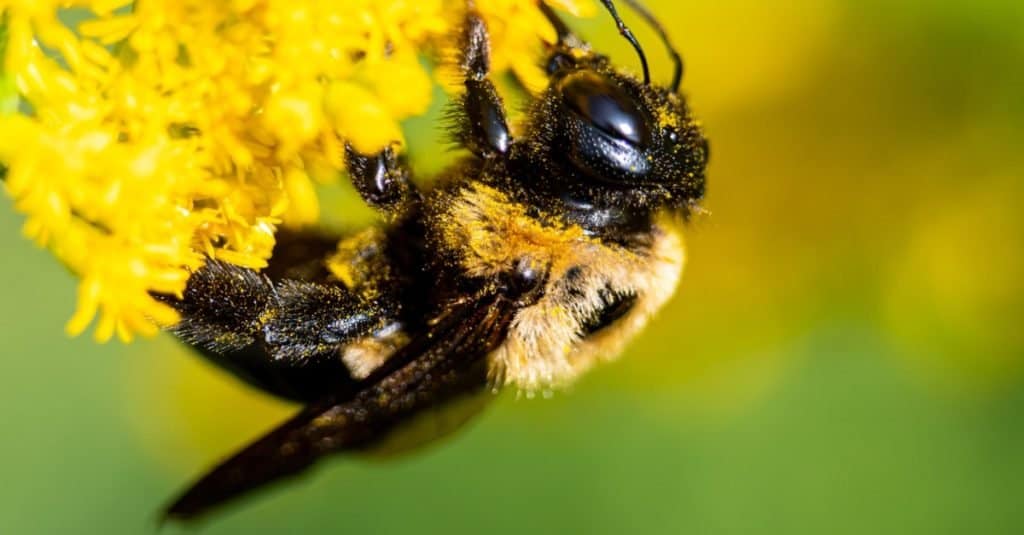
All bumblebees have stingers, regardless of their gender, while only female carpenter bees have stingers.
©Brier Mitchell/Shutterstock.com
One main difference between a carpenter bee vs. bumble bee is the presence of a stinger. All bumblebees have stingers, regardless of their gender, while only female carpenter bees have stingers. This is often not something that people know, given that carpenter bees swarm people if they feel threatened. However, only female carpenter bees are capable of stinging, and they only do so in order to protect their hive.
The same can be said for bumble bees, as most bee species will not sting unless they feel threatened. They are primarily docile insects, though female bumble bees will also sting if they feel as if their hive and fellow bees are threatened.
Carpenter Bee vs Bumble Bee: Appearance

Carpenter bees can be found in a variety of colors, while bumblebees are usually only found in one.
©vallefrias/Shutterstock.com
Another key difference between carpenter bees and bumble bees is their overall appearance. Carpenter bees often get a bad rap given that they are all black and shiny in appearance, while bumblebees have rounded and soft looking bodies. You can easily tell these two bees apart when they are side by side, as a carpenter bee will likely look far more threatening.
Both of these bees have segmented body parts, with a bumble bee looking uniform across all sections. A carpenter bee tends to have a shiny black section of its body, in addition to a potentially fuzzy section as well. Carpenter bees can also be found in a variety of colors, while bumblebees are usually only found in their trademark yellow and black stripes.
Carpenter Bee vs Bumble Bee: Size and Wing Shape
The size and wing shape of a carpenter bee vs bumble bee is another way that you can tell them apart. For instance, carpenter bees are often larger in length when compared to bumble bees. Carpenter bee wings are also larger and more streamlined when compared to the rounded wings of a bumble bee.
However, carpenter bees and bumble bees can be very similar in their overall length. The average carpenter bee is roughly an inch long, while many bumblebees also reach this size, if not larger.
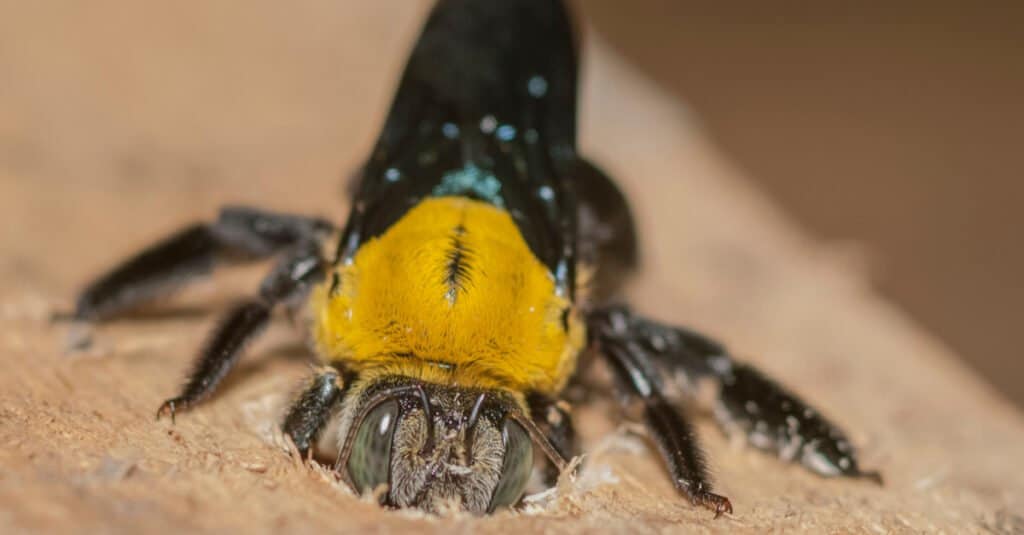
Carpenter bee wings are larger and more streamlined when compared to the rounded wings of a bumble bee.
©Yuttana Joe/Shutterstock.com
Carpenter Bee vs Bumble Bee: Species Classification
Another key difference between carpenter bees versus bumble bees is their species classification. These two bees may be called bees, but they are both from distinct families. Carpenter bees are from the Xylocopa family and bumble bees are from the Bombus family. While this may not help you tell them apart in your backyard garden, this is a key distinction between these two species.
Carpenter Bee vs Bumble Bee: Behavior
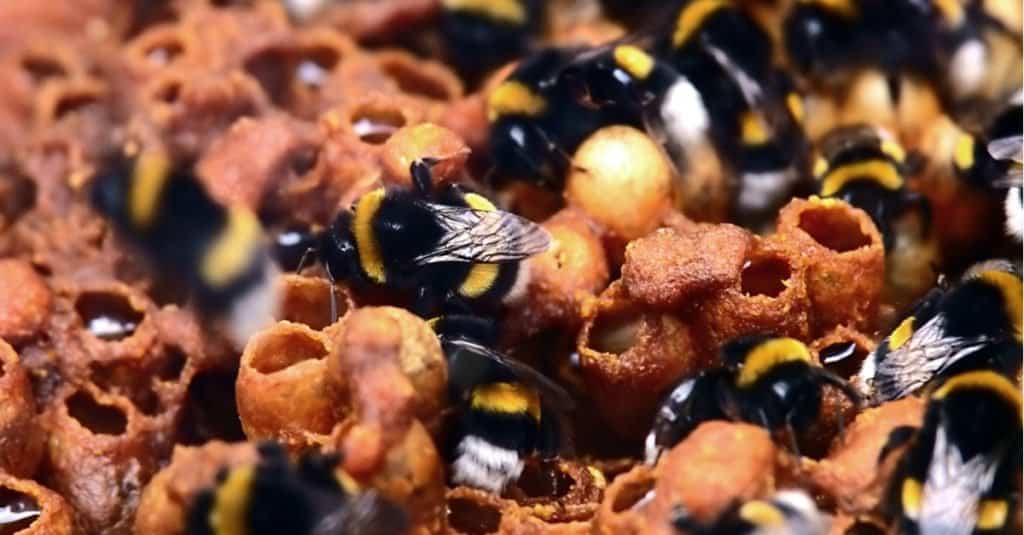
Carpenter bees are from the
Xylocopafamily and bumble bees are from the
Bombusfamily.
©dwphotos/Shutterstock.com
A final difference between carpenter bees and bumble bees lies in their overall behavior. For example, carpenter bees make their hives in wood materials that they bore into, while bumble bees tend to make their hives along the ground and choose abandoned burrows or otherwise protected areas that they don’t have to build themselves.
The flight patterns of carpenter bees differ from bumble bees as well. Carpenter bees tend to fly in a more erratic and sharp way, while bumble bees take a more leisurely route while they fly around. Bumble bees are also likely found around blossoming plants and flowers, while carpenter bees tend to stick closely to their preferred wooden environments.
Carpenter bees also tend to get a worse rap than bumblebees in terms of their behavior. They tend to buzz around people’s heads if they feel threatened, even if they don’t sting. Bumble bees prefer to keep to themselves and tend to leave humans alone until their hive is threatened.
The photo featured at the top of this post is © Zety Akhzar/Shutterstock.com
Thank you for reading! Have some feedback for us? Contact the AZ Animals editorial team.



